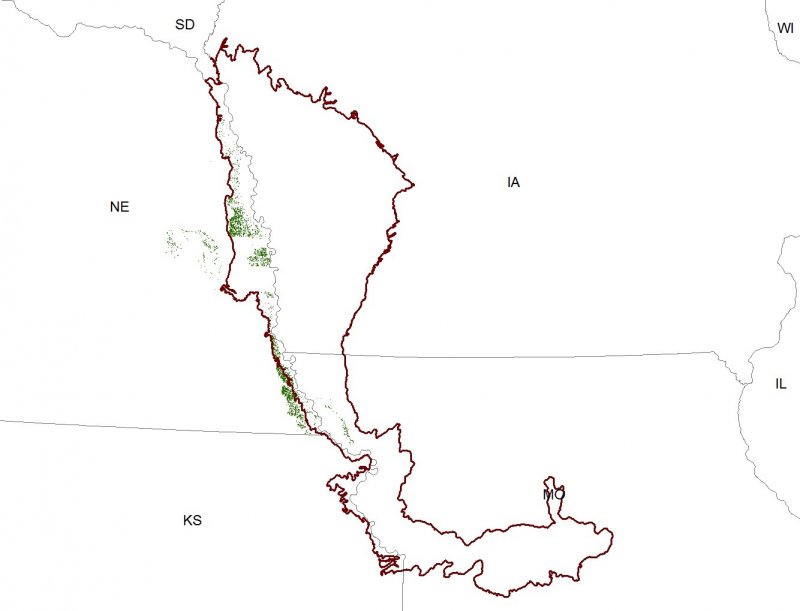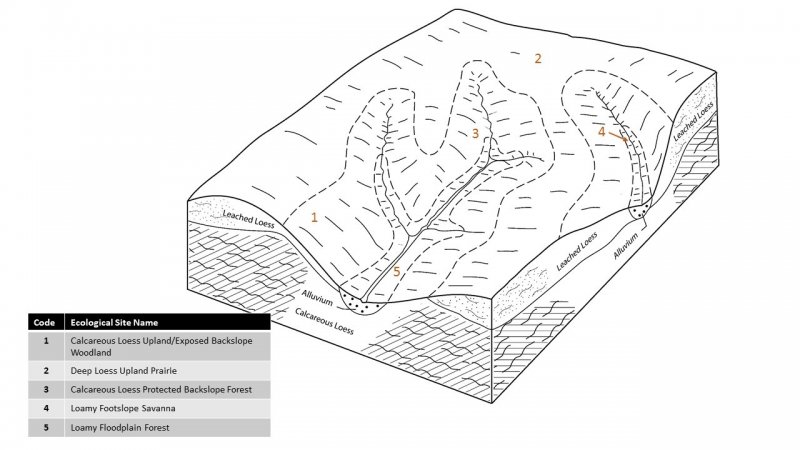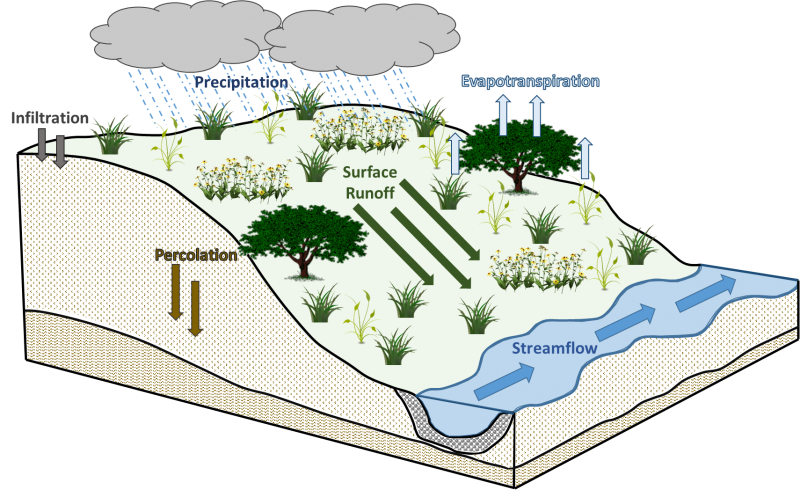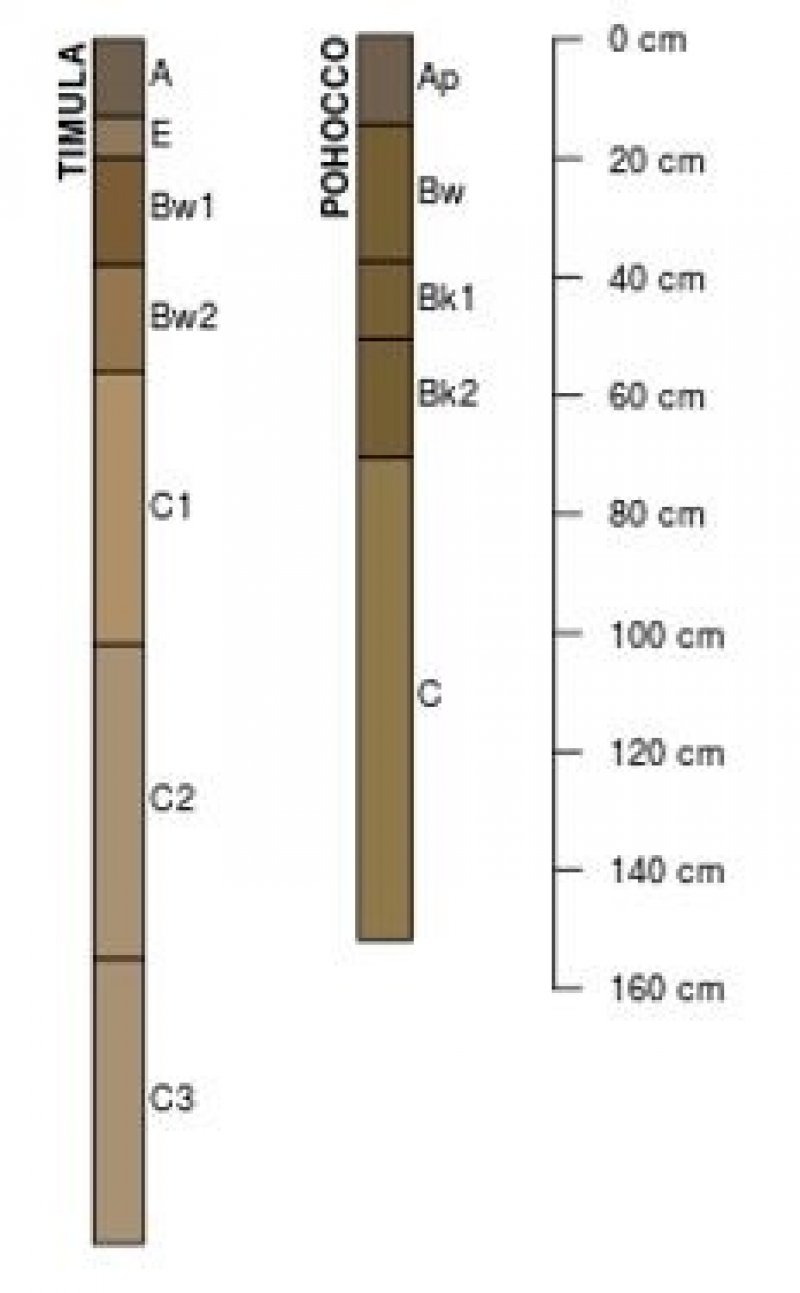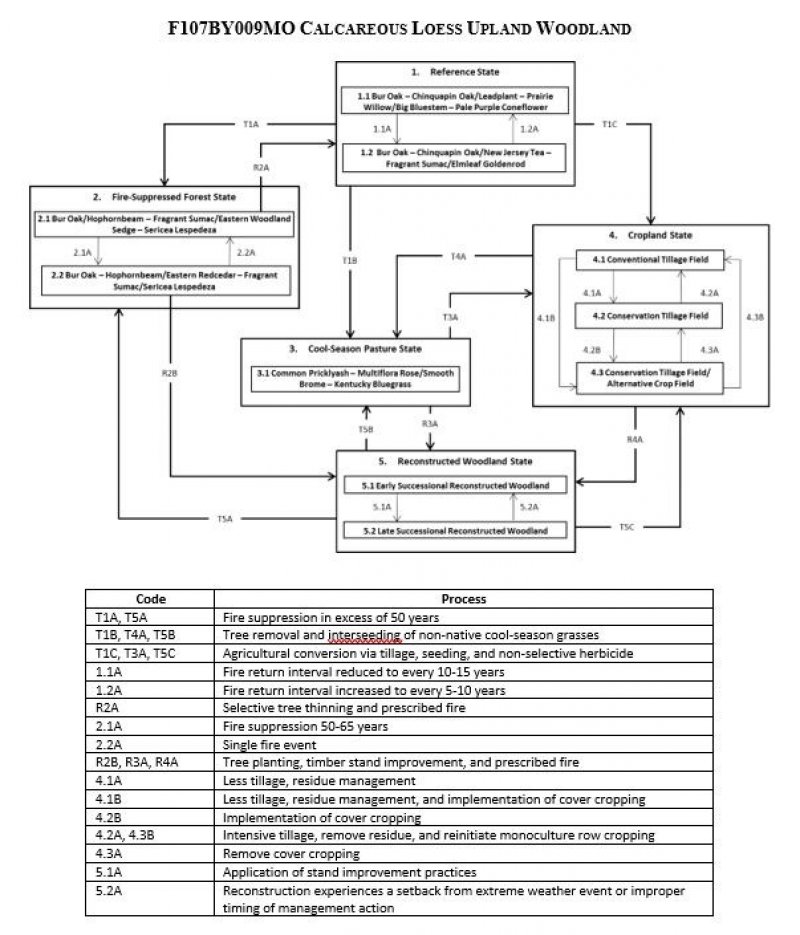Ecological dynamics
The Loess Hills region lies within the transition zone between the eastern deciduous forests and the Great Plains. The heterogeneous topography of the area results in variable microclimates and fuel matrices that in turn are able to support prairies, savannas, woodlands, and forests (Novacek et al. 1985; Nelson 2010). Calcareous Loess Upland Woodlands form an aspect of this vegetative continuum. This ecological site occurs on summits on calcareous soils. Species characteristic of this ecological site consist of oaks and tallgrass prairie species.
Fire is the most important ecosystem driver for maintaining this ecological site (Dey and Kabrick 2015). Fire intensity typically consisted of periodic, low-to-moderate severity surface fires (LANDFIRE 2009). Ignition sources included summertime lightning strikes from convective storms and bimodal, human ignitions during the spring and fall seasons. Native Americans regularly set fires to improve sight lines for hunting, driving large game, improving grazing and browsing habitat, agricultural and village clearing, and enhancing vital ethnobotanical plants (Day 1953; Barrett 1980; White 1994). Historic fire frequency has been estimated to occur on average every 6.6 years in the Loess Hills region (Stambaugh et al. 2006).
Drought has also played a role in shaping the woodland ecosystems in the Loess Hills. The periodic episodes of reduced soil moisture in conjunction with the well-drained soils have favored the proliferation of plant species tolerant of such conditions (Stambaugh et al. 2006). In addition, drought can also slow the growth of plants and result in dieback of certain species. When coupled with fire, periods of drought can also greatly delay the recovery of woody vegetation, substantially altering the extent of shrubs and trees (Pyne et al. 1996).
Grazing by native ungulates, ice storms, and periodic insect pest damage serve as an important secondary disturbance factors in wooded ecosystems, helping to shape stand composition, structure, condition, and functional complexity (Irland 2000; Briggs et al. 2002; LANDFIRE 2009). Grazing from native ungulates, such as bison (Bison bison), encourages the growth of woody plants by reducing understory species as well as reducing fine fuels that help carry fire into the woodlands (Briggs et al. 2002). Damage to stands from storms and pests can vary from minor, patchy effects of individual trees to major stand effects that could shift overstory composition (Irland 2000). In the case of Calcareous Loess Upland Woodlands, periodic canopy openings from ice storms and insect defoliation as well as reduced competition from grasses and sedges can provide opportunities for the shade-intolerant oaks to regenerate.
Today, many Calcareous Loess Upland Woodland sites have been converted to row-crop agriculture or pasture and are likely to remain as such for the foreseeable future. In addition, grazing and fire suppression have reduced the integrity of remaining woodlands. Sites where remnant woodlands occur have experienced a shift in species composition and cover, and the current woodlands exhibit a more-closed canopy plant community. In addition, invasion by non-native species (e.g., sericea lespedeza (Lespedeza cuneata (Dum. Cours.) G. Don)) is rapidly threatening the remaining native community.
State 1
Reference State
The reference plant community is categorized as an open oak woodland. The two community phases within the reference state are dependent on a fire frequency of every two to fifteen years. Shorter fire intervals maintain dominance by tallgrass prairie species in the understory, while less frequent intervals allow more shade-tolerant species to increase in importance. Drought, ice storm, periodic insect defoliation, and native grazing disturbances have less impact in the reference phases, but do contribute to overall species composition, diversity, cover, and productivity.
Community 1.1
Bur Oak – Chinquapin Oak/Leadplant – Prairie Willow/Big Bluestem – Pale Purple Coneflower
Bur oak and chinquapin oak are the dominant tree components of this phase with lesser components of white oak and black oak. Canopy height is moderate (30 to 60 feet) and coverage is classified as open and is estimated at approximately 30 percent (Nelson 2010). It is maintained by surface fires approximately every two to five years (LANDFIRE 2009). Leadplant and prairie willow are sun-loving shrubs and are diagnostic of the open woodland community phase. The herbaceous layer is moderately vegetated, typically with tallgrass prairie associates such as big bluestem and pale purple coneflower. Other common understory species include little bluestem (Schizachyrium scoparium (Michx.) Nash), pointedleaf ticktrefoil (Desmodium glutinosum (Muhl. ex Willd.) Alph. Wood), and wild quinine (Parthenium integrifolium L.) (Nelson 2010).
Community 1.2
Bur Oak – Chinquapin Oak/New Jersey Tea – Fragrant Sumac/Elmleaf Goldenrod
This reference community phase can occur when fire frequency is increased to approximately every five to ten years (LANDFIRE 2009). Oaks continue to serve as the dominant canopy cover (which can increase to over 80 percent), but the reduced fire interval allows the more shade-tolerant shrubs to increase in the sub-canopy such as New Jersey tea and fragrant sumac. The understory sees an increase to slightly more shade-tolerant species such as elmleaf goldenrod (Solidago ulmifolia Muhl. ex Willd.) and fringeleaf wild petunia (Ruellia humilis Nutt.) (Steinauer and Rolfsmeier 2010).
Pathway P1.1A
Community 1.1 to 1.2
Natural succession as a result of an average fire return interval of five to ten years.
Pathway P1.2A
Community 1.2 to 1.1
Natural succession as a result of surface fires within ten years.
State 2
Fire Suppressed Forest State
Fire suppression can transition the reference oak woodland community into a closed-canopy fire-suppressed forest state. This state is evidenced by a closed-canopy that is overstocked and overgrown with a sparse herbaceous understory. Invasive and exotic species, particularly Eastern redcedar (Juniperus virginiana L.) and sericea lespedeza, have invaded these sites and decreased the understory diversity (Nelson 2010).
Community 2.1
Bur Oak/Hophornbeam – Fragrant Sumac/Eastern Woodland Sedge – Sericea Lespedeza
This community phase represents a shift to a closed-canopy forest state. The fire-intolerant hophornbeam (Ostrya virginiana (Mill.) K. Koch) becomes dominant in the subcanopy along with the more shade-tolerant fragrant sumac. The herbaceous layer continues to shift to more shade-tolerant species such as eastern woodland sedge (Carex blanda Dewey) and Virginia creeper (Parthenocissus quinquefolia (L.) Planch). The exotic sericea lespedeza invades the most heavily-disturbed areas, and its alleopathic properties further suppress the understory (Nelson 2010).
Community 2.2
Bur Oak – Hophornbeam/Eastern Redcedar – Fragrant Sumac/Virginia Creeper – Sericea Lespedeza
Hophornbeam becomes co-dominant with bur oak in the overstory canopy, while Eastern redcedar becomes a co-dominant with fragrant sumac (Nelson 2010; Steinauer and Rolfsmeier 2010). As the canopy closes, the understory becomes less populous, and only the most shade-tolerant species persist. Sericea lespedeza continues to occupy sites that are disturbed (Nelson 2010).
Pathway P2.1A
Community 2.1 to 2.2
Fire is removed from the landscape in excess of 65 years.
Pathway P2.2A
Community 2.2 to 2.1
Fire occurs within 50 years.
State 3
Cool Season Pasture
The cool-season pasture state occurs when the reference state has been anthropogenically-altered for livestock production. Early settlers harvested the trees for timber and fuel and seeded such non-native cool-season species as smooth brome (Bromus inermis Leyss.) and Kentucky bluegrass (Poa pratensis L.), converting the woodland to pasture (Smith 1998; IDNR 2013). Over time, as lands were continually grazed by large herds of cattle, the non-native species were able to spread and expand across the site, reducing the native species diversity.
Community 3.1
Common Pricklyash – Multiflora Rose/Smooth Brome – Kentucky Bluegrass
Sites in this community phase arise from tree removal and seeding of non-native cool-season grasses. Bur oaks provided a valuable source of fuel and timber for early settlers, and many were harvested as a result, leaving widely-spaced individuals. Smooth brome and Kentucky bluegrass were common species used for pasture planting. Grazing by livestock maintains this simplified grassland state.
State 4
Cropland State
The Midwest is well-known for its highly-productive agricultural soils, and as a result, much of the MLRA has been converted to cropland, including portions of this ecological site. The continuous use of tillage, row-crop planting, and chemicals (i.e., herbicides, fertilizers, etc.) have effectively eliminated the reference community and many of its natural ecological functions in favor of crop production. Corn (Zea mays L.) and soybeans (Glycine max (L.) Merr.) are the dominant crops for the site. These areas are likely to remain in crop production for the foreseeable future.
Community 4.1
Conventional Tillage Field
Sites in this community phase typically consist of monoculture row-cropping maintained by conventional tillage practices. They are cropped in either continuous corn or corn-soybean rotations. The frequent use of deep tillage, low crop diversity, and bare soil conditions during the non-growing season negatively impact soil health. Under these practices, soil aggregation is reduced or destroyed, soil organic matter is reduced, erosion and runoff are increased, and infiltration is decreased, which can ultimately lead to undesirable changes in the hydrology of the watershed (Tomer et al. 2005).
Community 4.2
Conservation Tillage Field
This community phase is characterized by rotational crop production that utilizes various conservation tillage methods to promote soil health and reduce erosion. Conservation tillage methods include strip-till, ridge-till, vertical-till, or no-till planting systems. Strip-till keeps seedbed preparation to narrow bands less than one-third the width of the row where crop residue and soil consolidation are left undisturbed in-between seedbed areas. Strip-till planting may be completed in the fall and nutrient application either occurs simultaneously or at the time of planting. Ridge-till uses specialized equipment to create ridges in the seedbed and vegetative residue is left on the surface in between the ridges. Weeds are controlled with herbicides and/or cultivation, seedbed ridges are rebuilt during cultivation, and soils are left undisturbed from harvest to planting. Vertical-till systems employ machinery that lightly tills the soil and cuts up crop residue, mixing some of the residue into the top few inches of the soil while leaving a large portion on the surface. No-till management is the most conservative, disturbing soils only at the time of planting and fertilizer application. Compared to conventional tillage system, conservation tillage methods can reduce soil erosion, increase organic matter and water availability, improve water quality, and reduce soil compaction.
Community 4.3
Conservation Tillage Field/Alternative Crop Field
This condition applies conservation tillage methods as described above as well as adds cover crop practices. Cover crops typically include nitrogen-fixing species (e.g., legumes), small grains (e.g., rye, wheat, oats), or forage covers (e.g., turnips, radishes, rapeseed). The addition of cover crops not only adds plant diversity but also promotes soil health by reducing soil erosion, limiting nitrogen leaching, suppressing weeds, increasing soil organic matter, and improving the overall soil. In the case of small grain cover crops, surface cover and water infiltration are increased, while forage covers can be used to graze livestock or support local wildlife. Of the three community phases for this state, this phase promotes the greatest soil sustainability and improves ecological functioning within a cropland system.
Pathway P4.1A
Community 4.1 to 4.2
Tillage operations are greatly reduced, crop rotation occurs on a regular schedule, and crop residue is allowed to remain on the soil surface.
Pathway P4.1B
Community 4.1 to 4.3
Tillage operations are greatly reduced or eliminated, crop rotation is either reduced or eliminated, and crop residue is allowed to remain on the soil surface, and cover crops are implemented to prevent soil erosion.
Pathway P4.2A
Community 4.2 to 4.1
Intensive tillage is utilized and monoculture row-cropping is established.
Pathway P4.2B
Community 4.2 to 4.3
Implementation of cover cropping.
Pathway P4.3B
Community 4.3 to 4.1
Intensive tillage is utilized, cover crops practices are abandoned, monoculture row-cropping is established, and crop rotation is reduced or eliminated.
Pathway P4.3A
Community 4.3 to 4.2
Remove cover cropping.
State 5
Reconstructed Woodland State
The combination of natural and anthropogenic disturbances occurring today has resulted in a number of forest health issues, and restoration back to the historic reference condition may not always be feasible. Woodlands and forests are being stressed by non-native diseases and pests, habitat fragmentation, permanent changes in soil hydrology, and overabundant deer populations on top of naturally-occurring disturbances (severe weather and native pests) (Flickinger 2010). However, these habitats provide multiple ecosystem services including carbon sequestration; clean air and water; soil conservation; biodiversity support; wildlife habitat; timber, fiber, and fuel products; as well as a variety of cultural activities (e.g., hiking, camping, hunting) (Millennium Ecosystem Assessment 2005; Flickinger 2010). Therefore, conservation of forests and woodlands should still be pursued. Woodland reconstructions are an important tool for repairing natural ecological functioning and providing habitat protection for numerous species of Calcareous Loess Upland Woodlands. Therefore ecological restoration should aim to aid the recovery of degraded, damaged, or destroyed ecosystems. A successful restoration will have the ability to structurally and functionally sustain itself, demonstrate resilience to the ranges of stress and disturbance, and create and maintain positive biotic and abiotic interactions (SER 2002). The reconstructed woodland state is the result of a long-term commitment involving a multi-step, adaptive management process.
Community 5.1
Early Successional Reconstructed Woodland
This community phase represents the early community assembly from woodland reconstruction. It is highly dependent on the current condition of the woodland based on past and current land management actions, invasive species, and proximity to land populated with non-native pests and diseases. Therefore, no two sites will have the same early successional composition. Technical forestry assistance should be sought to develop suitable stewardship management plans.
Community 5.2
Late Successional Reconstructed Woodland
Appropriately timed management practices (e.g., prescribed fire, hazardous fuels management, forest stand improvement, continuing integrated pest management) applied to the early successional community phase can help increase the stand maturity, pushing the site into a late successional community phase over time. A late successional reconstructed woodland will have an uneven-aged canopy and a well-developed understory.
Pathway P5.1A
Community 5.1 to 5.2
Application of stand improvement practices in line with a developed management plan.
Pathway P5.2A
Community 5.2 to 5.1
Reconstruction experiences a setback from extreme weather event or improper timing of management actions.
Transition T1A
State 1 to 2
Fire suppression transitions this site to the fire-suppressed forest state (2).
Transition T1B
State 1 to 3
Tree removal and interseeding non-native cool-season grasses transition this site to the cool-season pasture state (3).
Transition T1C
State 1 to 4
Tillage, seeding of agricultural crops, and non-selective herbicide transition this site to the cropland state (4).
Restoration pathway R2A
State 2 to 1
Selective tree thinning and prescribed fire is used to restore this site to the reference state (1).
Restoration pathway R2B
State 2 to 5
Site preparation, invasive species control (native and non-native), tree planting, and prescribed fire transition this site to the reconstructed woodland state (5).
Transition T3A
State 3 to 4
Tillage, seeding of agricultural crops, and non-selective herbicide transition this site to the cropland state (4).
Restoration pathway R3A
State 3 to 5
Site preparation, invasive species control (native and non-native), tree planting, and prescribed fire transition this site to the reconstructed woodland state (5).
Transition T4A
State 4 to 3
Non-selective herbicide and seeding of non-native cool-season grasses transitions the site to the cool-season pasture state (3).
Transition R4A
State 4 to 5
Site preparation, invasive species control (native and non-native), tree planting, and prescribed fire transition this site to the reconstructed woodland state (5).
Transition T5A
State 5 to 2
Fire (or fire surrogate) suppression efforts transition this site to the fire-suppressed forest state (2).
Restoration pathway T5B
State 5 to 3
Tree removal and interseeding non-native cool-season grasses transition this site to the cool-season pasture state (3).
Transition T5C
State 5 to 4
Tillage, seeding of agricultural crops, and non-selective herbicide transition this site to the cropland state (4).

